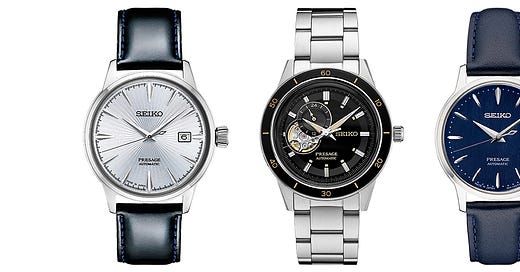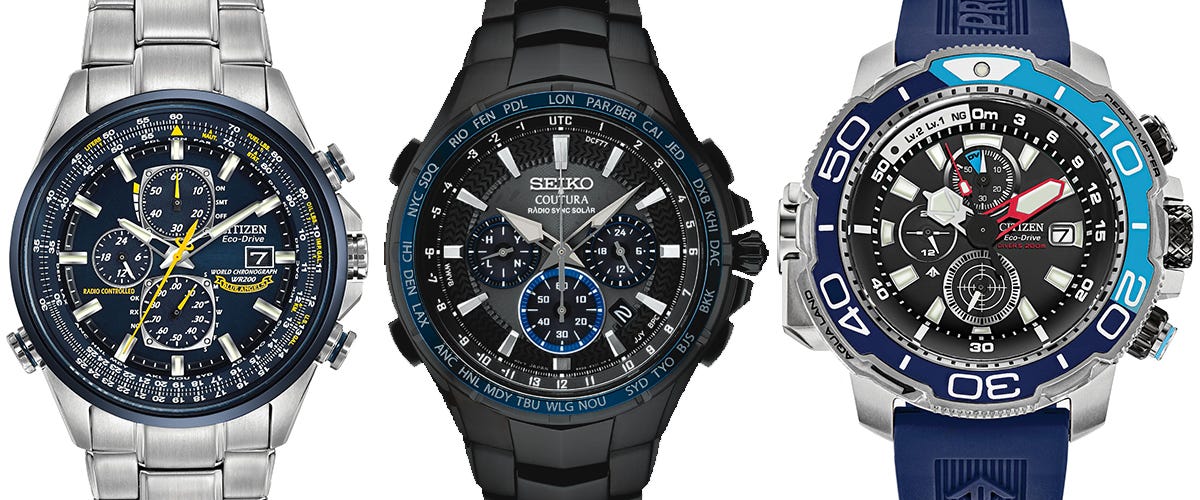Introduction To Watches: Men's Fashion 202
Which watches to wear for maximum impact
Watches are arguably the biggest flex for high rollers. Without an upper limit, watches above $100,000 aren’t unheard of. However, in terms of fashion, why shell out $20,000 for a watch if a $300 watch is functionally and aesthetically similar?
Expensive watches have their place. (If you know, you know.) But there are diminishing returns, and aesthetics should be the priority. Especially now. These days, it isn’t a good idea to flex in public, due to rough economic conditions. Obvious luxury items can paint a target on your back.
My #1 recommendations are Citizen and Seiko. Their light-powered and automatic-drive watches never need battery replacements. The quality is good and they’re sufficiently stylish.
But before we go further, let’s look into the different parts of a watch. This will let you know what to wear and when.
What goes into a watch’s construction?
There are only a few relevant factors: movement, size, glass, and strap.
Watch Movement
Quartz is the global standard. It’s reliable and low-cost due to fewer moving parts. Quartz movements are created by a battery electrifying a small quartz crystal; the resulting vibrations keep the motor moving. Watch hands tick along at an accurate rate.
Mechanical movement requires more craftsmanship. They use an intricate series of gears and springs for power. This makes the watch more expensive, so most manufacturers go with quartz. Cheaping out on mechanical movement is a recipe for disaster.
Manual-wind watches must be wound by hand every few days to keep time.
Automatic watches have a free-moving rotor making it self-winding. The rotor spins as you move around (it doesn’t take much) and keeps the watch powered (indefinitely, if you wear the watch near-daily). If you don’t wear the watch for a while, it’ll need manual winding OR it’ll wind itself over time (depends on the manufacturer)
Automatic quartz, invented by Seiko, is a combination of the two. Multiple watch manufacturers use this now, although most watches still don’t use it. Pure quartz or pure mechanical is favored.
Digital watches, including smartwatches and LCD, usually don’t have moving parts.
Side note: time may be calibrated with Satellite or Atomic technology in some watches.
Watch Case Sizing
Small: 38-40 mm
Medium: 40-42 mm
Large: more than 42 mm
Medium fits most men. Pay attention to the ratio of size-to-wrist and see if it’s aesthetic to you. Nobody wants a watch that’s so big it overpowers their wrist. A big watch on a small wrist implies weakness and lack of muscle. A small watch on a big wrist implies carelessness and femininity (women’s watches are much smaller than men’s).
Types of Watch Glass
Acrylic - Basically plexiglass. It’s cheap, lightweight, and you can buff out scratches. Watches under $100 use this. Cheaper/thinner plastic can easily dent or bend.
Mineral - Fairly scratch-resistant and unlikely to shatter. Mid-tier watches ($100-300) use mineral glass as a nice compromise between acrylic and sapphire.
Sapphire-coated mineral - This is a newer invention, with good scratch resistance at a solid price. However, it doesn’t have the same durability as pure sapphire.
Sapphire - Sapphire crystal dial protectors have high durability. They’re resistant to scratches and have good clarity. Rolex led the way on this for widespread adoption. All high-end watches use sapphire, and some mid-tiers too. Watches with sapphire start at $300-500.
Types of Watch Bands/Straps
Fabric - Casual strap of cotton canvas or synthetics (like nylon). Some people prefer the feel over leather, even if the latter is superior.
Rubber - Casual style for the gym, swimming, or diving. Repels sweat and water.
Leather - Works for both casual and formal events. Real leather is of course preferred over fake leatherette (plastic) bands. This is the most versatile strap style.
Metal - Formal style, though it can work with some casual outfits. Partly depends on the type of metal and design.
The golden rule is for your watch band to match your belt and shoes whenever possible.
I might make some infographics for this. Each segment could have its own article, given the depth of information and variety of options.
That’s it for the essentials. Nobody cares if you can define the difference between parts like a bezel, tourbillion, and crown.
Recommendations on Watches to Buy
For under $100, something with good durability is Casio’s G-Shock line. A used one will be even cheaper.
For $150-500, we’re back to Citizen and Seiko. Anything should be fine as long as it fits your aesthetic preferences. Both brands are reliable, affordable, and come in a wide variety of styles. Frequent discounts and sales often keep these under $300.
Note that the more simple the face design is, the more formal it is. A “dress watch” tends to be understated and elegant. Check out the below images and guess which ones are for semi-formal or formal outfits.
I don’t recommend chronograph styles because of the cluttered appearance. You don’t need them unless you know you need them.
Seiko’s “Presage” line is $400-600 MSRP and high quality. If you have the budget for it, I’d start here.
Citizen’s “classic” line is their best starting point, aesthetically.
Orient watches are owned by Seiko and can go under $150 during sales. They have a similar variety as the above.
For upgrades in the $1000-3000 range:
The premium arm of each brand is fairly unnecessary. Go big or go small. The regular lines are perfectly fine.
I don’t recommend smartwatches. Traditional watches look better and don’t have EMF. Still, people have their reasons for enjoying smartwatches. Apple watches have been around for a while, Google Pixel Watch is coming soon, etc.
Conclusion
There’s a lot which can go into choosing a watch. I’ll discuss more on Substack and Twitter.
For someone’s first or second watch, I recommend:
Mechanical movement
Medium size (depending on your wrist)
Sapphire crystal
Leather strap (light brown or dark brown) or metal bracelet
This varies depending on needs and budget.
That’s it for now. Subscribe for continued aesthetics alpha:
Or DM me on Twitter with any questions, comments, or consulting requests.
Read the full series:
The Foundations: Men’s Fashion 101
Dress Codes and Style: Men’s Fashion 102
How To Choose Your Wardrobe Colors: Men’s Fashion 103
Introduction to Fit: Men’s Fashion 104
Introduction to Shoes: Men’s Fashion 201
Introduction to Watches: Men’s Fashion 202 ←- you are here
Introduction to Accessories: Men’s Fashion 203
Introduction to Fragrances: Men’s Fashion 204
Introduction to Hairstyles and Beards: Men’s Fashion 205







